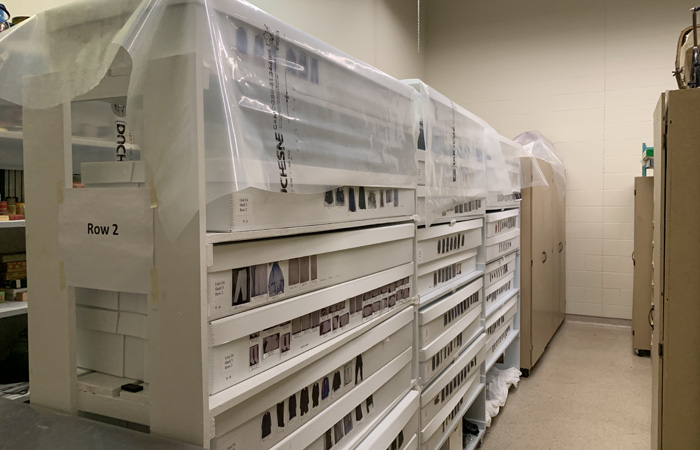Village News
Behind-the-Scenes of Collections Care

While this summer has been an unusual one at the museum, the curatorial department has used the opportunity of the break in the regular summer routine to focus on some major collections-based projects. A large part of my job, along with Curatorial Assistant Kara Suderman, is to keep track of the items in Mennonite Heritage Village’s (MHV) collection. This is done in a number of ways: we assign a unique identifying number to each item that is accessioned into our collection; we catalogue each item added to the collection into our artefact database; and we update the location of every object every time it moves, like when we move it from its permanent location in storage to a temporary location in the lab for research. These tasks sound pretty straightforward when you think of a few dozen objects cared for by one person; they suddenly get much more complicated when you consider that MHV’s collection has over 16,500 objects and that over the museum’s 54-year-history, numerous people from directors (in the museum’s early days when the director oversaw the collection) to curators have been in charge of this work.
One of our greatest tools in maintaining a well-organized and well-documented collection is our artefact database. Originally, paper records were kept for identifying the items in the collection. These paper records tracked each item in the collection by organizing them according to accession number and by category. The move from paper-based artefact records to Virtual Collections, a FileMaker Pro-based database tailored specifically for museums, occurred in the early 2000s. This move greatly improved the curator’s ability to track the location of each object, but also to search for objects based on broader range of criteria. For example, it allows us to search for keyword searches like “World War,” period searches like “1870s,” or object name searches like “Gesangbuch.” This increased searchability was, as you can imagine, a great asset for selecting artefacts for exhibits, finding out how many items in our collection had a connection to a specific event, or figuring out how many objects of one type are held in the collection. Virtual Collections was a tool that greatly improved MHV’s ability to care for its collection.
Time is generally not friendly to software, however, and Virtual Collections is no exception. Twenty years after MHV first began to use this database, it is no longer supported by the company that created it. Therefore, part of my job for the last few years has been to research our next possible artefact database. Migrating a database to a new platform is a serious and sizeable project and we are investigating some exciting possibilities for a new database tailored specifically to our needs, that would allow us to continue the work of caring well for the collection.
In preparation for this future move to a new database, Kara and I are busy with some key tasks that will help to ensure that the data held in Virtual Collections is as standardized, correct, and as up-to-date as possible. First, we are cleaning the data, which means we perform systematic checks of the information recorded in the database to make sure it conforms to professional museum practices, like standardized naming and numbering formats, and that all locations where artefacts may be located throughout the museum are written in a standardized way.
Another area of collections work we are engaged with is ensuring that the data contained in Virtual Collections is as correct and up-to-date as it can be. We do this by performing inventories on our collections in storage. This project compares the location listed in the database for a given object with its actual physical location in the collections storage room. It provides us with an opportunity to account for each item in the collection, as well as to address any storage issues. There are sixteen rows in the collections storage room, each with several units, and each unit contains five to eight shelves, so the inventory is a large project that will take a few years to complete.
This collections work happens largely behind-the-scenes at the museum, so you likely will not see it going on. But our hope is that, when the time comes to migrate our database to a new platform in the near future, we will be working with the cleanest data and most up-to-date information about our collection.




